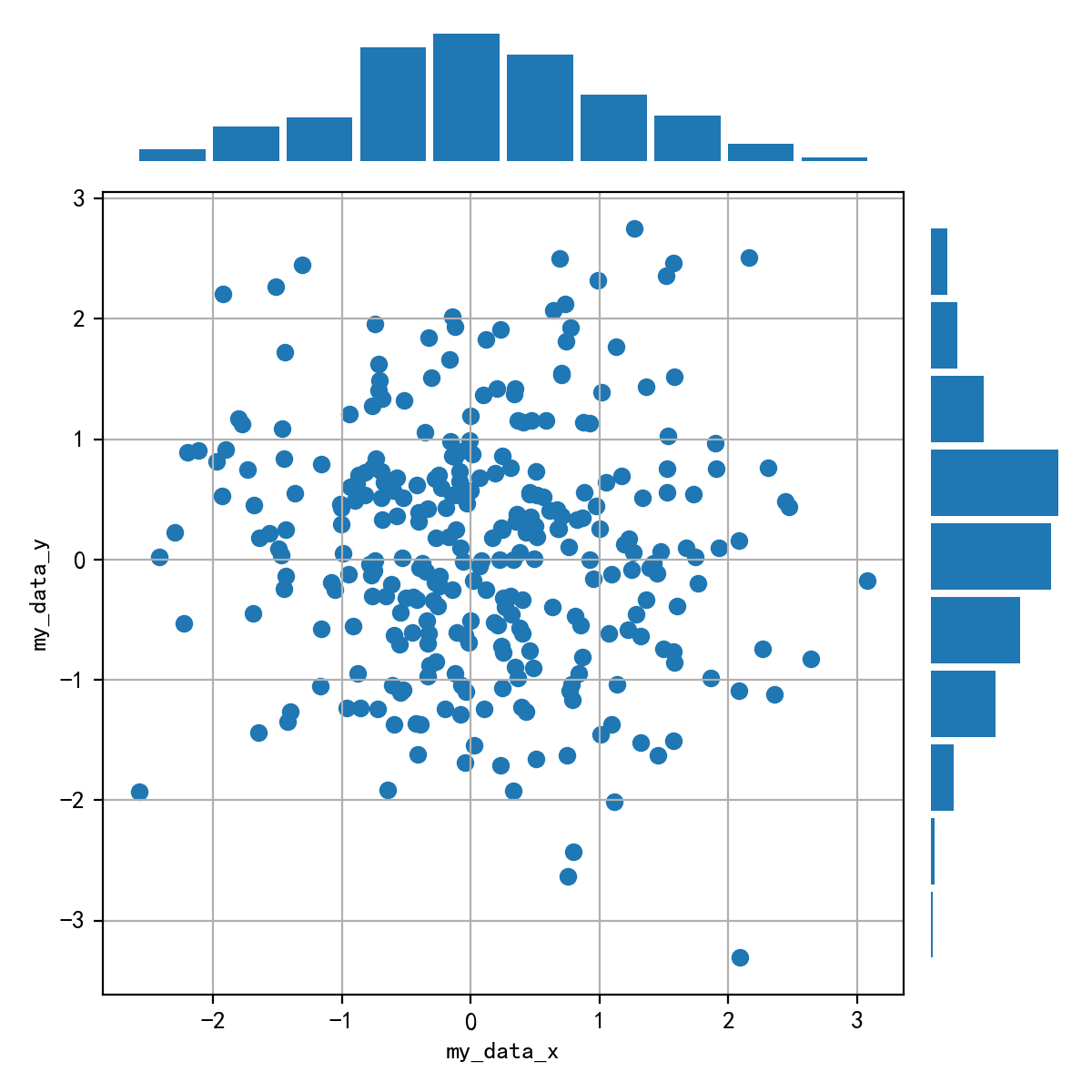#!/usr/bin/env python
# coding: utf-8
# # 第三回:布局格式定方圆
# In[2]:
import numpy as np
import pandas as pd
import matplotlib.pyplot as plt
plt.rcParams['font.sans-serif'] = ['SimHei']
plt.rcParams['axes.unicode_minus'] = False
# ## 一、子图
#
# ### 1. 使用 `plt.subplots` 绘制均匀状态下的子图
#
# 返回元素分别是画布和子图构成的列表,第一个数字为行,第二个为列
#
# `figsize` 参数可以指定整个画布的大小
#
# `sharex` 和 `sharey` 分别表示是否共享横轴和纵轴刻度
#
# `tight_layout` 函数可以调整子图的相对大小使字符不会重叠
# In[2]:
fig, axs = plt.subplots(2, 5, figsize=(10, 4), sharex=True, sharey=True)
fig.suptitle('样例1', size=20)
for i in range(2):
for j in range(5):
axs[i][j].scatter(np.random.randn(10), np.random.randn(10))
axs[i][j].set_title('第%d行,第%d列'%(i+1,j+1))
axs[i][j].set_xlim(-5,5)
axs[i][j].set_ylim(-5,5)
if i==1: axs[i][j].set_xlabel('横坐标')
if j==0: axs[i][j].set_ylabel('纵坐标')
fig.tight_layout()
# 除了常规的直角坐标系,也可以通过`projection`方法创建极坐标系下的图表
# In[5]:
N = 150
r = 2 * np.random.rand(N)
theta = 2 * np.pi * np.random.rand(N)
area = 200 * r**2
colors = theta
plt.subplot(projection='polar')
plt.scatter(theta, r, c=colors, s=area, cmap='hsv', alpha=0.75)
# ### 2. 使用 `GridSpec` 绘制非均匀子图
#
# 所谓非均匀包含两层含义,第一是指图的比例大小不同但没有跨行或跨列,第二是指图为跨列或跨行状态
#
# 利用 `add_gridspec` 可以指定相对宽度比例 `width_ratios` 和相对高度比例参数 `height_ratios`
# In[3]:
fig = plt.figure(figsize=(10, 4))
spec = fig.add_gridspec(nrows=2, ncols=5, width_ratios=[1,2,3,4,5], height_ratios=[1,3])
fig.suptitle('样例2', size=20)
for i in range(2):
for j in range(5):
ax = fig.add_subplot(spec[i, j])
ax.scatter(np.random.randn(10), np.random.randn(10))
ax.set_title('第%d行,第%d列'%(i+1,j+1))
if i==1: ax.set_xlabel('横坐标')
if j==0: ax.set_ylabel('纵坐标')
fig.tight_layout()
# 在上面的例子中出现了 `spec[i, j]` 的用法,事实上通过切片就可以实现子图的合并而达到跨图的共能
# In[4]:
fig = plt.figure(figsize=(10, 4))
spec = fig.add_gridspec(nrows=2, ncols=6, width_ratios=[2,2.5,3,1,1.5,2], height_ratios=[1,2])
fig.suptitle('样例3', size=20)
# sub1
ax = fig.add_subplot(spec[0, :3])
ax.scatter(np.random.randn(10), np.random.randn(10))
# sub2
ax = fig.add_subplot(spec[0, 3:5])
ax.scatter(np.random.randn(10), np.random.randn(10))
# sub3
ax = fig.add_subplot(spec[:, 5])
ax.scatter(np.random.randn(10), np.random.randn(10))
# sub4
ax = fig.add_subplot(spec[1, 0])
ax.scatter(np.random.randn(10), np.random.randn(10))
# sub5
ax = fig.add_subplot(spec[1, 1:5])
ax.scatter(np.random.randn(10), np.random.randn(10))
fig.tight_layout()
# ## 二、子图上的方法
#
# 在 `ax` 对象上定义了和 `plt` 类似的图形绘制函数,常用的有: `plot, hist, scatter, bar, barh, pie`
# In[5]:
fig, ax = plt.subplots(figsize=(4,3))
ax.plot([1,2],[2,1])
# In[6]:
fig, ax = plt.subplots(figsize=(4,3))
ax.hist(np.random.randn(1000))
# 常用直线的画法为: `axhline, axvline, axline` (水平、垂直、任意方向)
# In[7]:
fig, ax = plt.subplots(figsize=(4,3))
ax.axhline(0.5,0.2,0.8)
ax.axvline(0.5,0.2,0.8)
ax.axline([0.3,0.3],[0.7,0.7])
# 使用 `grid` 可以加灰色网格
# In[8]:
fig, ax = plt.subplots(figsize=(4,3))
ax.grid(True)
# 使用 `set_xscale, set_title, set_xlabel` 分别可以设置坐标轴的规度(指对数坐标等)、标题、轴名
# In[9]:
fig, axs = plt.subplots(1, 2, figsize=(10, 4))
fig.suptitle('大标题', size=20)
for j in range(2):
axs[j].plot(list('abcd'), [10**i for i in range(4)])
if j==0:
axs[j].set_yscale('log')
axs[j].set_title('子标题1')
axs[j].set_ylabel('对数坐标')
else:
axs[j].set_title('子标题1')
axs[j].set_ylabel('普通坐标')
fig.tight_layout()
# 与一般的 `plt` 方法类似, `legend, annotate, arrow, text` 对象也可以进行相应的绘制
# In[10]:
fig, ax = plt.subplots()
ax.arrow(0, 0, 1, 1, head_width=0.03, head_length=0.05, facecolor='red', edgecolor='blue')
ax.text(x=0, y=0,s='这是一段文字', fontsize=16, rotation=70, rotation_mode='anchor', color='green')
ax.annotate('这是中点', xy=(0.5, 0.5), xytext=(0.8, 0.2), arrowprops=dict(facecolor='yellow', edgecolor='black'), fontsize=16)
# In[11]:
fig, ax = plt.subplots()
ax.plot([1,2],[2,1],label="line1")
ax.plot([1,1],[1,2],label="line1")
ax.legend(loc=1)
# 其中,图例的 `loc` 参数如下:
#
# | string | code |
# | ---- | ---- |
# | best | 0 |
# | upper right | 1 |
# | upper left | 2 |
# | lower left | 3 |
# | lower right | 4 |
# | right | 5 |
# | center left | 6 |
# | center right | 7 |
# | lower center | 8 |
# | upper center | 9 |
# | center | 10 |
# ## 作业
#
# ### 1. 墨尔本1981年至1990年的每月温度情况
# In[3]:
ex1 = pd.read_csv('data/layout_ex1.csv')
ex1.head()
# - 请利用数据,画出如下的图:
#
#  # ### 2. 画出数据的散点图和边际分布
#
# - 用 `np.random.randn(2, 150)` 生成一组二维数据,使用两种非均匀子图的分割方法,做出该数据对应的散点图和边际分布图
#
#
# ### 2. 画出数据的散点图和边际分布
#
# - 用 `np.random.randn(2, 150)` 生成一组二维数据,使用两种非均匀子图的分割方法,做出该数据对应的散点图和边际分布图
#
# 
 # ### 2. 画出数据的散点图和边际分布
#
# - 用 `np.random.randn(2, 150)` 生成一组二维数据,使用两种非均匀子图的分割方法,做出该数据对应的散点图和边际分布图
#
#
# ### 2. 画出数据的散点图和边际分布
#
# - 用 `np.random.randn(2, 150)` 生成一组二维数据,使用两种非均匀子图的分割方法,做出该数据对应的散点图和边际分布图
#
# 